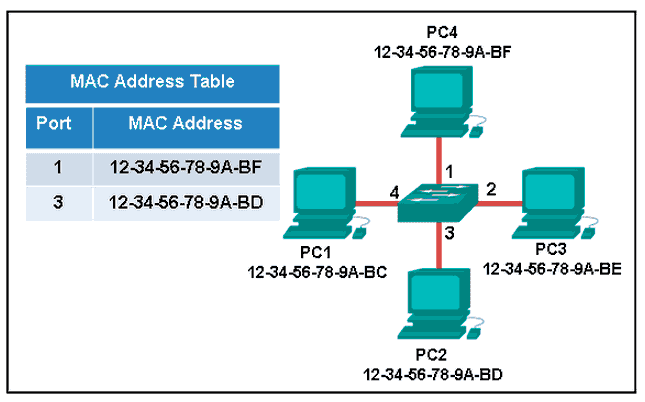Cisco CCNA 1 Simulation v6.0 Test Chapter 5
-
Questions and answers
Resumen
Cisco CCNA 1 Simulation v6.0 Test Chapter 5 Questions and Answers
CCNA 1 Chapter 5 Quiz Questions and Answers. In this simulation, take your test, get your score and share with others!
- Points: 100
- Questions: 22
- Time limit: None
- Allowed attempts: Unlimited
Exam Chapter 5 Questions and Answers CCNA 1 V6.0
What happens to runt frames received by a Cisco Ethernet switch?
In an attempt to conserve bandwidth and not forward useless frames, Ethernet devices drop frames that are considered to be runt (less than 64 bytes) or jumbo (greater than 1500 bytes) frames.
Which two statements describe features or functions of the logical link control sublayer in Ethernet standards? (Choose two.)
Por favor, selecciona 2 respuestas correctas
Logical link control is implemented in software and enables the data link layer to communicate with the upper layers of the protocol suite. Logical link control is specified in the IEEE 802.2 standard. IEEE 802.3 is a suite of standards that define the different Ethernet types. The MAC (Media Access Control) sublayer is responsible for the placement and retrieval of frames on and off the media. The MAC sublayer is also responsible for adding a header and a trailer to the network layer protocol data unit (PDU).
What is auto-MDIX?
Auto-MDIX is a feature that is enabled on the latest Cisco switches and that allows the switch to detect and use whatever type of cable is attached to a specific port.
What are the two sizes (minimum and maximum) of an Ethernet frame? (Choose two.)
Por favor, selecciona 2 respuestas correctas
The minimum Ethernet frame is 64 bytes. The maximum Ethernet frame is 1518 bytes. A network technician must know the minimum and maximum frame size in order to recognize runt and jumbo frames.
Fill in the blank.
A collision fragment, also known as a __ frame, is a frame of fewer than 64 bytes in length.
A runt frame is a frame of fewer than 64 bytes, usually generated by a collision or a network interface failure.
What statement describes Ethernet?
Ethernet is the most common LAN protocol in the world. It operates at Layer 1 and 2, but is not required for Internet communication. The OSI model is used to describe how networks operate. A WAN connects multiple sites located in different countries.
Refer to the exhibit. The switches are in their default configuration. Host A needs to communicate with host D, but host A does not have the MAC address for its default gateway. Which network hosts will receive the ARP request sent by host A?

Since host A does not have the MAC address of the default gateway in its ARP table, host A sends an ARP broadcast. The ARP broadcast would be sent to every device on the local network. Hosts B, C, and router R1 would receive the broadcast. Router R1 would not forward the message.
Which statement is true about MAC addresses?
A MAC address is composed of 6 bytes. The first 3 bytes are used for vendor identification and the last 3 bytes must be assigned a unique value within the same OUI. MAC addresses are implemented in hardware. A NIC needs a MAC address to communicate over the LAN. The IEEE regulates the MAC addresses.
Refer to the exhibit. PC1 issues an ARP request because it needs to send a packet to PC2. In this scenario, what will happen next?

When a network device wants to communicate with another device on the same network, it sends a broadcast ARP request. In this case, the request will contain the IP address of PC2. The destination device (PC2) sends an ARP reply with its MAC address.
The ARP table in a switch maps which two types of address together?
The switch ARP table keeps a mapping of Layer 2 MAC addresses to Layer 3 IP addresses. These mappings can be learned by the switch dynamically through ARP or statically through manual configuration.
True or False?
When a device is sending data to another device on a remote network, the Ethernet frame is sent to the MAC address of the default gateway.
A MAC address is only useful on the local Ethernet network. When data is destined for a remote network of any type, the data is sent to the default gateway device, the Layer 3 device that routes for the local network.
Match the characteristic to the forwarding method. (Not all options are used.)

Fill in the blank.
ARP __ is a technique that is used to send fake ARP messages to other hosts in the LAN. The aim is to associate IP addresses to the wrong MAC addresses.
ARP spoofing or ARP poisoning is a technique used by an attacker to reply to an ARP request for an IPv4 address belonging to another device, such as the default gateway.
What statement describes a characteristic of MAC addresses?
Any vendor selling Ethernet devices must register with the IEEE to ensure the vendor is assigned a unique 24-bit code, which becomes the first 24 bits of the MAC address. The last 24 bits of the MAC address are generated per hardware device. This helps to ensure globally unique addresses for each Ethernet device.
Fill in the blank.
On a Cisco switch, __ memory buffering is used to buffer frames in queues linked to specific incoming and outgoing ports.
What addressing information is recorded by a switch to build its MAC address table?
A switch builds a MAC address table by inspecting incoming Layer 2 frames and recording the source MAC address found in the frame header. The discovered and recorded MAC address is then associated with the port used to receive the frame.
Which switching method uses the CRC value in a frame?
When the store-and-forward switching method is used, the switch receives the complete frame before forwarding it on to the destination. The cyclic redundancy check (CRC) part of the trailer is used to determine if the frame has been modified during transit. In contrast, a cut-through switch forwards the frame once the destination Layer 2 address is read. Two types of cut-through switching methods are fast-forward and fragment-free.
Which statement describes the treatment of ARP requests on the local link?
Refer to the exhibit. The exhibit shows a small switched network and the contents of the MAC address table of the switch. PC1 has sent a frame addressed to PC3. What will the switch do with the frame?

The MAC address of PC3 is not present in the MAC table of the switch. Because the switch does not know where to send the frame that is addressed to PC3, it will forward the frame to all the switch ports, except for port 4, which is the incoming port.
What are two potential network problems that can result from ARP operation? (Choose two.)
Por favor, selecciona 2 respuestas correctas
Large numbers of ARP broadcast messages could cause momentary data communications delays. Network attackers could manipulate MAC address and IP address mappings in ARP messages with the intent to intercept network traffic. ARP requests and replies cause entries to be made into the ARP table, not the MAC address table. ARP table overflows are very unlikely. Manually configuring static ARP associations is a way to prevent, not facilitate, ARP poisoning and MAC address spoofing. Multiple ARP replies resulting in the switch MAC address table containing entries that match the MAC addresses of connected nodes and are associated with the relevant switch port are required for normal switch frame forwarding operations. It is not an ARP caused network problem.
Refer to the exhibit. A switch with a default configuration connects four hosts. The ARP table for host A is shown. What happens when host A wants to send an IP packet to host D?

Whenever the destination MAC address is not contained within the ARP table of the originating host, the host (host A in this example) will send a Layer 2 broadcast that has a destination MAC address of FF:FF:FF:FF:FF:FF. All devices on the same network receive this broadcast. Host D will respond to this broadcast.
Which destination address is used in an ARP request frame?
The purpose of an ARP request is to find the MAC address of the destination host on an Ethernet LAN. The ARP process sends a Layer 2 broadcast to all devices on the Ethernet LAN. The frame contains the IP address of the destination and the broadcast MAC address, FFFF.FFFF.FFFF.

Comparte tus Resultados:





